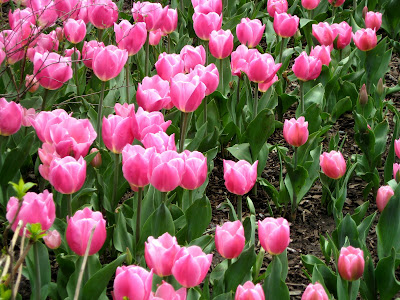Pink Tulips Spring Flowers. Central Park, New York City, New York. April 2007. Tulip bed near Straberry Fields in Central Park at 72d street and Central Park West.
I, (sookietex) the creator of this work, hereby release it into the public domain. This applies worldwide. In case this is not legally possible, I grant any entity the right to use this work for any purpose, without any conditions, unless such conditions are required by law.
If This image is subject to copyright in your jurisdiction, i (sookietex) the copyright holder have irrevocably released all rights to it, allowing it to be freely reproduced, distributed, transmitted, used, modified, built upon, or otherwise exploited in any way by anyone for any purpose, commercial or non-commercial, with or without attribution of the author, as if in the public domain.
Tulipa commonly called Tulip is a genus of about 100 species of bulbous flowering plants in the family Liliaceae. The native range of the species include southern Europe, north Africa, and Asia from Anatolia and Iran in the east to northeast of China. The centre of diversity of the genus is in the Pamir and Hindu Kush mountains and the steppes of Kazakhstan. A number of species and many hybrid cultivars are grown in gardens, used as pot plants or as fresh cut flowers.
The species are perennials from bulbs, the tunicate bulbs are often produced on the ends of stolons and covered with glabrous to variously hairy papery coverings. The species include short low growing plants to tall upright plants, growing from 10 to 70 centimeters (4–27 in) tall. Plants with typically 2 to 6 leaves, with some species having up to 12 leaves. The cauline foliage is strap-shaped, waxy-coated, usually light to medium green and alternately arranged.
The blades are somewhat fleshy and linear to oblong in shape. The large flowers are produced on scapes or subscapose stems normally lacking bracts. The stems have no leaves to a few leaves, with large species having some leaves and smaller species have none. Typically species have one flower per stem but a few species have up to four flowers. The colorful and attractive cup shaped flowers have three petals and three sepals, which are most often termed tepals because they are nearly identical.
The six petaloid tepals are often marked near the bases with darker markings. The flowers have six basifixed, distinct stamens with filaments shorter than the tepals and the stigmas are districtly 3-lobed. The ovaries are superior with three chambers. The 3 angled fruits are leathery textured capsules, ellipsoid to subglobose in shape, containing numerous flat disc-shaped seeds in two rows per locule.
Although tulips are associated with Holland, both the flower and its name originated in the Ottoman Empire. The tulip is actually not a Dutch flower as many people tend to believe. The tulip, or "Lale" as it is called in Turkey, is a flower indigenous to Iran, Afghanistan, Turkey and other parts of Central Asia. A Dutch ambassador in Turkey in the 16th century, who was also a great floral enthusiast, Ogier Ghiselin de Busbecq, got their very names because of their Persian origins.
Tulips were brought to Europe in the 16th century; the word tulip, which earlier in English appeared in such forms as tulipa or tulipant, entered the language by way of French tulipe and its obsolete form tulipan or by way of Modern Latin tulīpa, from Ottoman Turkish tülbend, "muslin, gauze." (The English word turban, first recorded in English in the 16th century, can also be traced to Ottoman Turkish tülbend.) The Turkish word for gauze, with which turbans can be wrapped, seems to have been used for the flower because a fully opened tulip was thought to resemble a turban.
This article is licensed under the GNU Free Documentation License. It uses material from the Wikipedia article, Tulip SEE FULL License, Credit and Disclaimer
















1 comment:
Thank you. These visions made me feel happy :)
Post a Comment